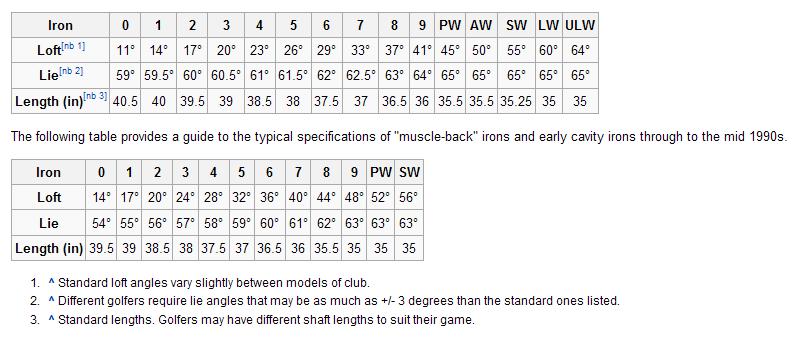

H0me page history

Golf course evolution
the pitching wedge and the sand wedge, as the numbered irons including the pitching wedge were de-lofted to compensate for cavity-backed irons' higher launch angle. The gap wedge has a loft similar to that of an older pitching wedge, around 52°, and can also be found labelled as an "Approach", "Dual", "Utility", or "Attack" wedge. Their use is generally similar to a pitching wedge, though some designs of gap wedge include additional "bounce" similar to a sand wedge for play from bunkers or other "soft" lies.
- The sand wedge, or sand iron, is primarily designed for use out of sand bunkers. It is generally lofted between 55-56°, and has the widest sole of the wedges which provides the greatest amount of "bounce", allowing the clubhead to glide through sand and avoid digging in.
- The lob wedge has a high degree of loft, around 60°, designed to produce shots with a very high arc, and are most often used for shots over hazards and other obstructions, or to accurately "drop" the ball into tight pin positions on modern elevated, undulating greens.
o The ultra lob wedge, also called the flop wedge by some makers, is a highly specialized, extremely high-lofted lob wedge (up to 70°), that is designed for situations where an almost vertical launch is required, such as shots from the "lip" of a bunker. They are generally only made by specialty companies, and are not in common usage.
Given the choices available to the modern golfer, the traditional pair of pitching wedge and sand iron is starting to become less common as players opt for a selection wedges with an array of different lofts and bounce angles. For example, a player may pick two gap wedges, one with low bounce but greater loft than a pitching wedge, and the other with similar bounce but less loft than a sand wedge, then add a lob wedge and forgo both of the traditional wedges.
Specifications
The following table provides a guide to the typical specifications of modern "cavity-back" irons. These can vary by 1-2° for a specific club set depending on manufacturer and player preferences.
Short irons
The 8 and 9 irons are commonly called the "short irons". They have the highest-mass clubheads and the shortest shafts of the numbered irons, and are used for shots requiring high loft and/or moderate to short distance (typically between 130 and 150 yards with a full swing). Shots that must carry over a stand of trees or a longer hazard like a lake, or approach shots from 140 yards or closer, are common short iron situations. The short irons also make good "bump and run" clubs; used with a putting motion from the fringe around the green, the ball will carry in the air a few yards over the thick grass that would hamper a putt, then land softly on the green where it will then roll for a distance like a putt.
The short irons are traditionally regarded as the easiest to hit; however they are typically used in situations requiring very high accuracy, and so it becomes critical to minimize any effect of mis-hits. Short irons are often constructed using steel shafts, even if lower-lofted irons in the set have graphite; the steel minimizes clubhead torquing, increasing the consistency and thus accuracy of shots made at the cost of reduced flex which reduces distance (a secondary concern in most situations where these irons are used).
The pitching wedge is on the cusp between the short irons and the wedges, and has behaviors and uses falling into either class. Most matched iron sets include a pitching wedge, and it follows the normal loft progression of the iron set. In some sets, such as older sets produced by MacGregor Golf, it is labelled the 10-iron (MacGregor has since adopted the "P" terminology common to other manufacturers). In other sets such as Callaway Golf's "Big Bertha" line, the set includes a 10-iron in addition to a pitching wedge (simply labelled "W"), and the wedge's loft is increased from a nominal 45-48° to 50°, as a means to "close the gap" in lofts between a modern pitching wedge and a modern sand wedge.
Wedges
Wedges are a subclass of irons with higher loft than numbered irons, used for a variety of specialized "utility" shots that require short distance (typically less than 130 yards), high launch angle, and/or high backspin to reduce roll distance. The first wedge to have that name was the sand wedge, invented by Gene Sarazen in 1931, which features a wide sole that is angled complementary to the striking face to help prevent the clubhead "digging in" to soft turf such as sand. This wide sole was added to other high-lofted irons to add mass to the clubhead (compensating for the shorter shafts) and gives wedges their name, alluding to the clubs' appearance in profile.
Wedges are used for approach shots to the putting green, getting the ball out of tough situations, and to escape from hazards. They are designed to produce a high, short trajectory with a high degree of spin, all of which cuts down on the distance the ball will roll after landing. Most golfers will generally have at least two wedges, traditionally a pitching wedge and a sand wedge, with a lob wedge or a gap wedge commonly being added to provide additional options. Wedges are usually identified by a letter denoting their function (P, G, S, L, etc. sometimes with a "W" appended), or depending on the manufacturer, with a number denoting their loft angle (52°, 56°, 60°) and "bounce angle" (0-12°).
The traditional pitching wedge had a loft of about 50-52°, but the "de-lofting" of modern cavity back irons including the pitching wedge has resulted in a loft range centering around 48°.
- The gap wedge was created to fill the gap that appeared between

Golf origins

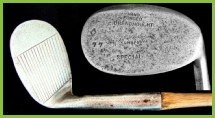
Golf short irons

Equipment development

Golf clubs components
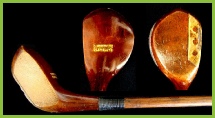
Golf woods
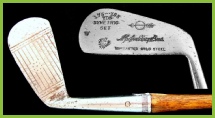
Long and mid irons

Golf putter
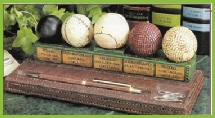
Golf balls

Glossary
